Our verdict
- Top pick in best trail running shoes for women (2025)
Pros
- Durable upper
- Vibram Megagrip outsole
- Still lightweight for its size
- Supportive and stable ride
- Increased cushioning
- Improved tongue design
- Still reasonably priced
- Revamped heel collar
Cons
- Disappointing breathability
- Rigidity increase
- Outsole durability concerns
- Lacks energy return
Audience verdict
- Top 15% most popular running shoes
Comparison
The most similar running shoes compared
+ + Add a shoe | |||||
|---|---|---|---|---|---|
| Audience score | 78 Decent! | 87 Great! | 94 Superb! | 89 Great! | |
| Price | $155 | $180 | $160 | $150 | |
| Trail terrain | Moderate | Moderate | LightModerate | Light | |
| Shock absorption | Moderate | Moderate | - | Moderate | |
| Energy return | Low | Moderate | - | Low | |
| Arch support | Neutral | Neutral | Neutral | Neutral | |
| Weight lab Weight brand | 9.8 oz / 278g 9.8 oz / 277g | 10.7 oz / 302g 10.7 oz / 303g | 11.4 oz / 322g 10.2 oz / 290g | 10.3 oz / 292g 10.9 oz / 309g | |
| Drop lab Drop brand | 4.9 mm 5.0 mm | 4.0 mm 4.0 mm | 6.2 mm 4.0 mm | 6.0 mm 5.0 mm | |
| Strike pattern | Mid/forefoot | Mid/forefoot | Mid/forefoot | Mid/forefoot | |
| Size | Slightly small | True to size | True to size | True to size | |
| Midsole softness | Balanced | Soft | Balanced | Balanced | |
| Difference in midsole softness in cold | Small | Small | Normal | Small | |
| Toebox durability | Good | Good | Decent | Decent | |
| Heel padding durability | Good | Good | Good | Bad | |
| Outsole durability | Decent | Good | Decent | Good | |
| Breathability | Warm | Moderate | Breathable | Warm | |
| Width / fit | Medium | Medium | Medium | Narrow | |
| Toebox width | Medium | Wide | Medium | Medium | |
| Stiffness | Stiff | Moderate | Stiff | Moderate | |
| Torsional rigidity | Stiff | Stiff | Stiff | Stiff | |
| Heel counter stiffness | Moderate | Flexible | Moderate | Moderate | |
| Lug depth | 4.0 mm | 4.0 mm | 3.2 mm | 3.1 mm | |
| Heel stack lab Heel stack brand | 32.1 mm 40.0 mm | 30.3 mm 36.0 mm | 32.8 mm 28.5 mm | 31.7 mm 29.0 mm | |
| Forefoot lab Forefoot brand | 27.2 mm 35.0 mm | 26.3 mm 32.0 mm | 26.6 mm 24.5 mm | 25.7 mm 24.0 mm | |
| Widths available | NormalWide | Normal | Normal | NarrowNormal | |
| For heavy runners | ✓ | ✗ | ✗ | ✗ | |
| Season | All seasons | All seasons | SummerAll seasons | All seasons | |
| Removable insole | ✓ | ✓ | ✓ | ✓ | |
| Orthotic friendly | ✓ | ✓ | ✓ | ✓ | |
| Ranking | #334 Bottom 11% | #147 Top 40% | #139 Top 37% | #151 Top 41% | |
| Popularity | #53 Top 15% | #98 Top 27% | #351 Bottom 6% | #195 Bottom 48% |
Who should buy
We think the Speedgoat 6 is an excellent choice for:
- Fans of the Speedgoat 5 looking for a similar feel but with added cushioning for longer runs.
- Trail runners who often face cold conditions—its lower ventilation excels in cooler climates.
- Those who prefer a snug fit seeking a versatile trail shoe that works well in dry and wet conditions.

Who should NOT buy
We think the Speedgoat 6 may not be a wise choice for some runners. For those with wider feet or who prefer a roomier fit, it might not be suitable due to its notably tapered toe area. We recommend considering the Altra Olympus 5 for its spacious feel and Vibram outsole; or the Brooks Caldera 7, which offers superior, plush cushioning.
Additionally, the Speedgoat 6 lacks sufficient energy return and breathability—two crucial attributes for many runners, especially in ultra distances. For those concerned about these aspects, the Nike Zegama 2 is a better alternative, featuring a Vibram Megagrip outsole, springy ZoomX cushioning, and enhanced ventilation, though at a slightly higher price.
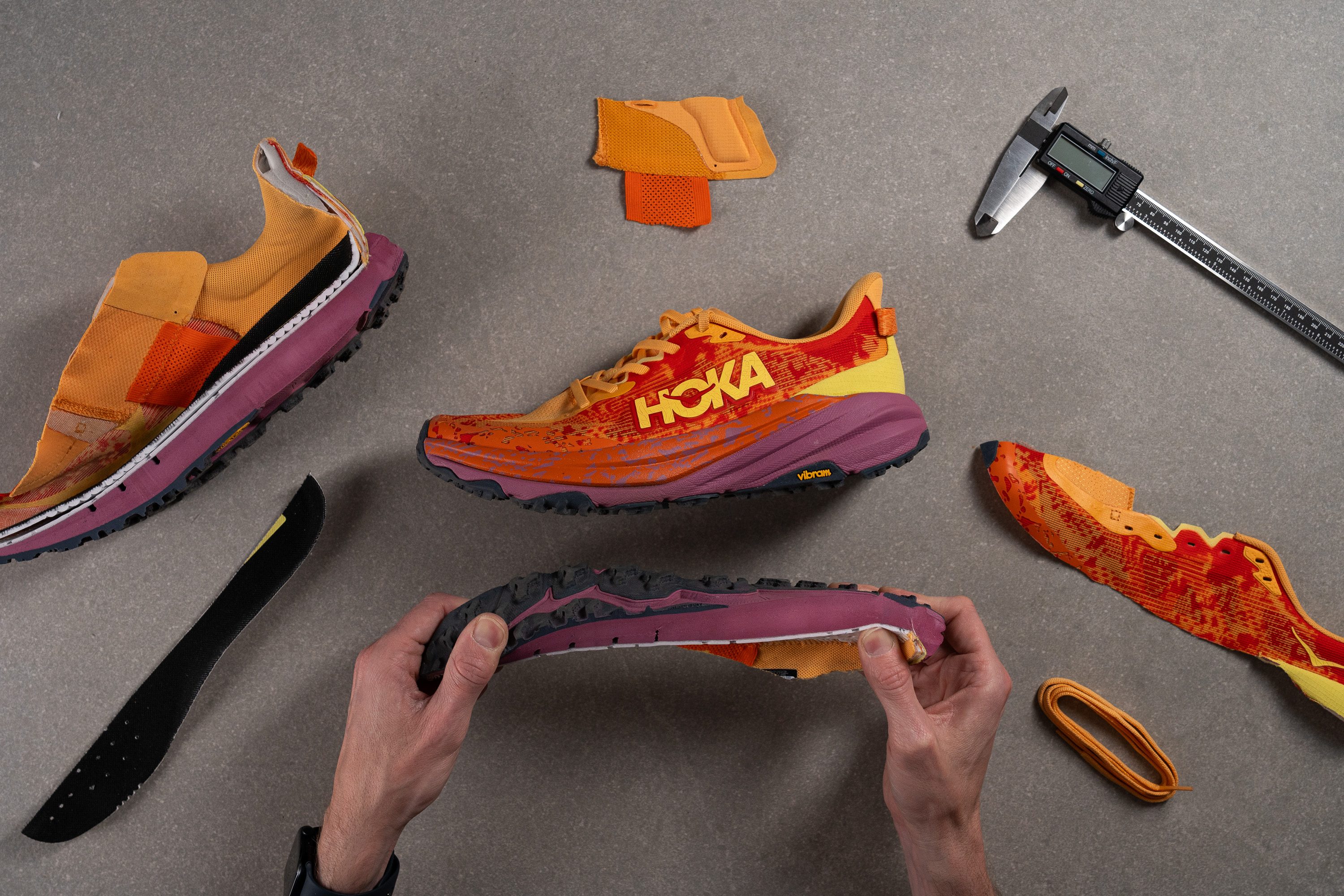
Cushioning
Shock absorption
The Speedgoat 6 gets some improvements for day-long outings with better shock absorption, reaching 124 SA in the heel and 107 SA in the forefoot in our ASTM F1976 lab test.
But we also believe Hoka should keep the model at this level, adding more cushioning would risk making it too bulky.

| Hoka Speedgoat 6 | 124 SA |
| Average | 122 SA |
Energy return
While shock absorption improved, we weren’t too pleased with energy return. It only reached 48.0% in the heel, an underwhelming result that makes the shoe less appealing for runners who want even a touch of performance. And we can't understand why Hoka didn't use the supercritical EVA from the Mach 6, to be honest.
| Hoka Speedgoat 6 | 48.0% |
| Average | 55.6% |
Heel stack
It appears that nowadays, when a brand updates a shoe line, the cushioning just increases, and the Speedgoat is no exception.
From the previous 27.5 mm in the heel of version 5, we've noted a significant increase. The latest version boasts a heel height of 32.1 mm, which is a considerable boost of 4.6 mm. This enhancement significantly boosts its appeal for long-distance runners and those who strike with their heels.
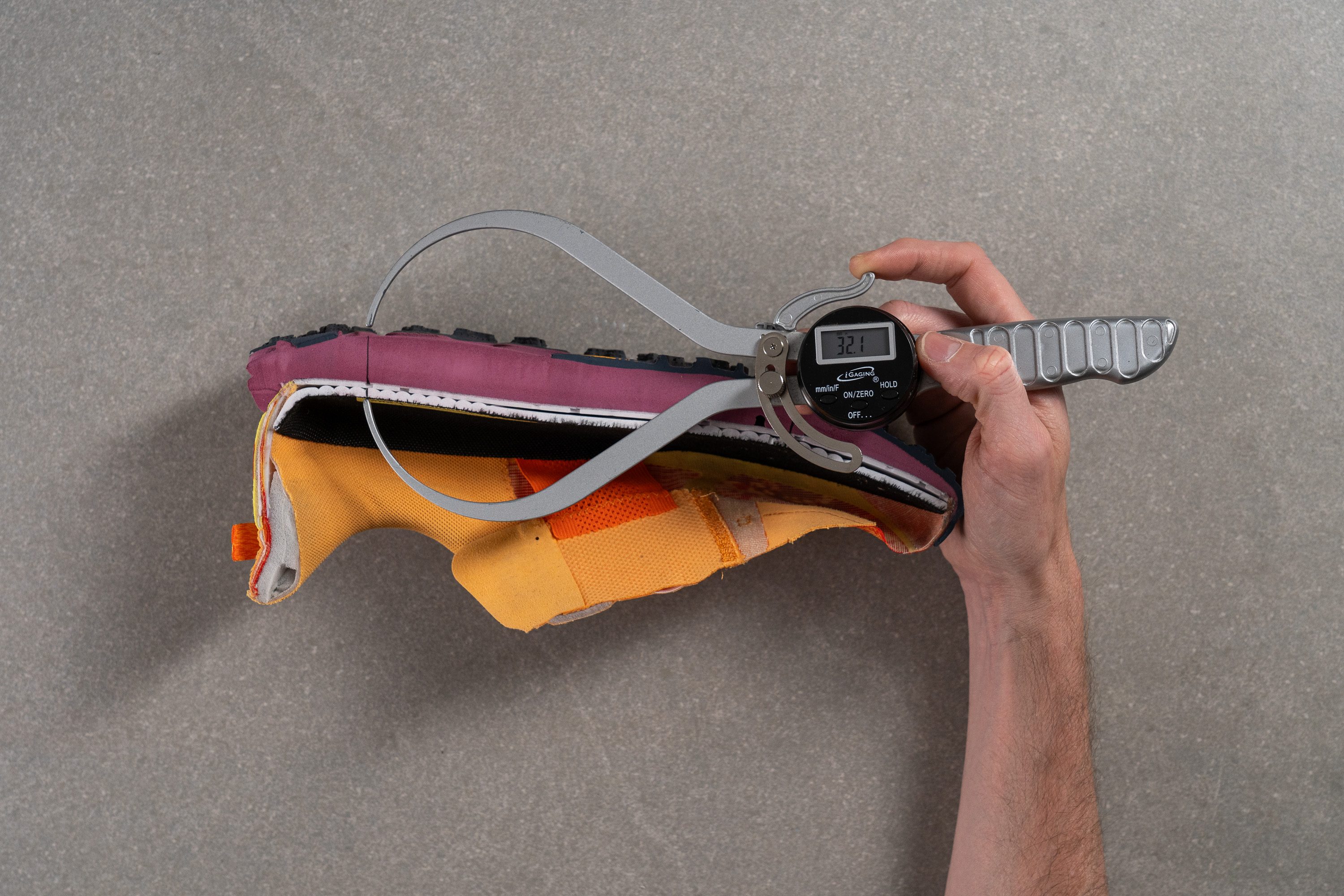
| Hoka Speedgoat 6 | 32.1 mm |
| Average | 32.6 mm |
Forefoot stack
In the forefoot, we noted a similar increase in stack height, which will be ideal for heavier individuals who found the cushioning of the SG5 a bit lacking for ultra distances.
At 27.2 mm, this enhanced cushioning sounds perfect for tackling multi-hour challenges.
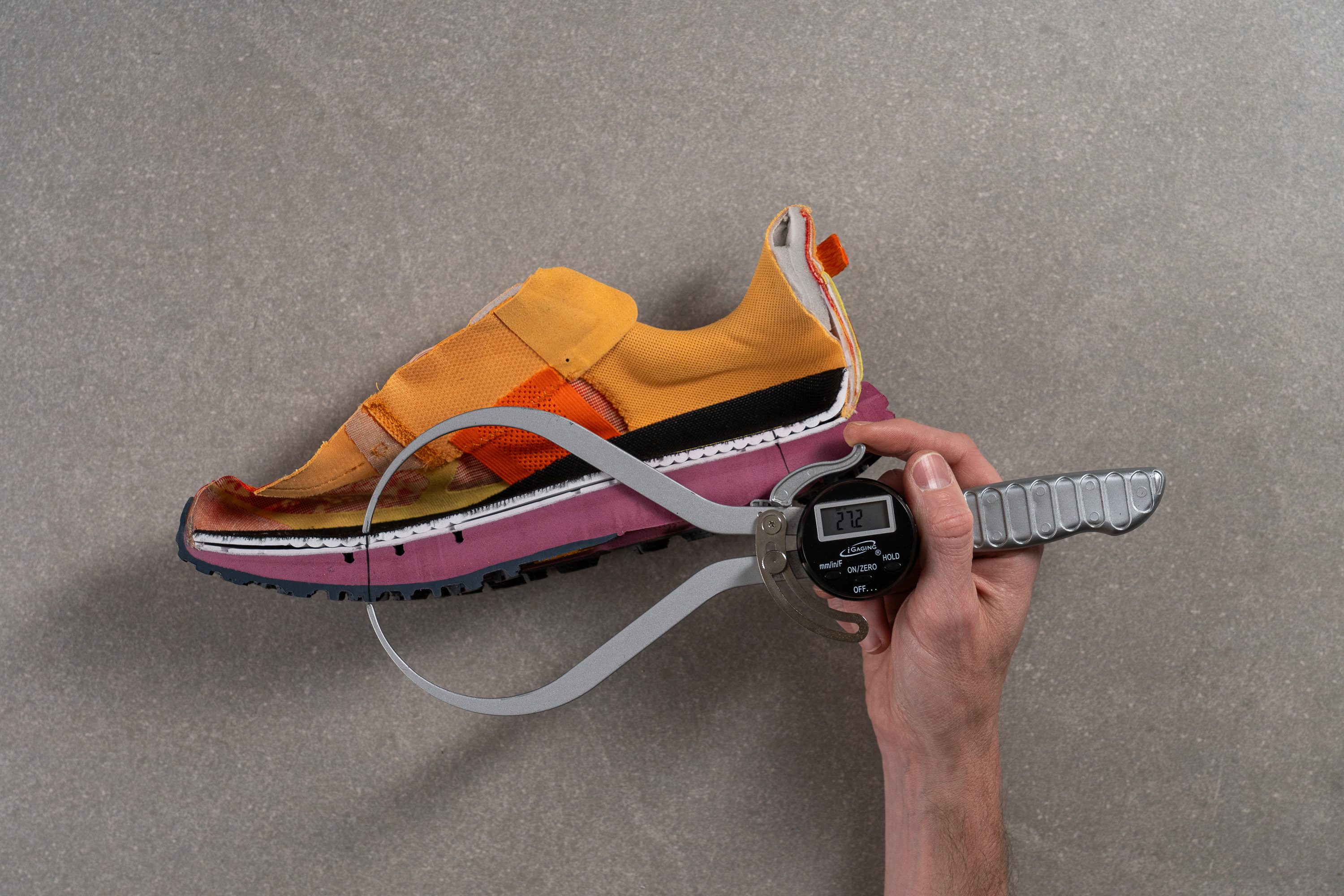
| Hoka Speedgoat 6 | 27.2 mm |
| Average | 25.1 mm |
Drop
Hoka claims that the Speedgoat 6 features a 5-mm heel-to-toe drop, and our measurements of 4.9 mm confirm this with impressive accuracy—a testament to Hoka's precise manufacturing. We often encounter much larger deviations in other shoes!
The 5 mm offset represents the classic low-to-moderate drop that Hoka usually features. We think this is a smart approach, as anything less might not suit heel strikers well, while a higher drop could prove less effective on technical terrains. And the Speedgoat is designed to perform excellently across all types of environments.

| Hoka Speedgoat 6 | 4.9 mm |
| Average | 7.5 mm |
Midsole softness
We had high hopes that Hoka would upgrade the Speedgoat 6 with a superior supercritical foam like that used in the best-selling Mach 6. Unfortunately, they have continued to use the CMEVA (Compression-Molded EVA) midsole, a choice that proved to be a significant disappointment for us.
As we proved before, it falls short of the performance enhancements offered by supercritical EVA, not to mention the premium PEBA foams.
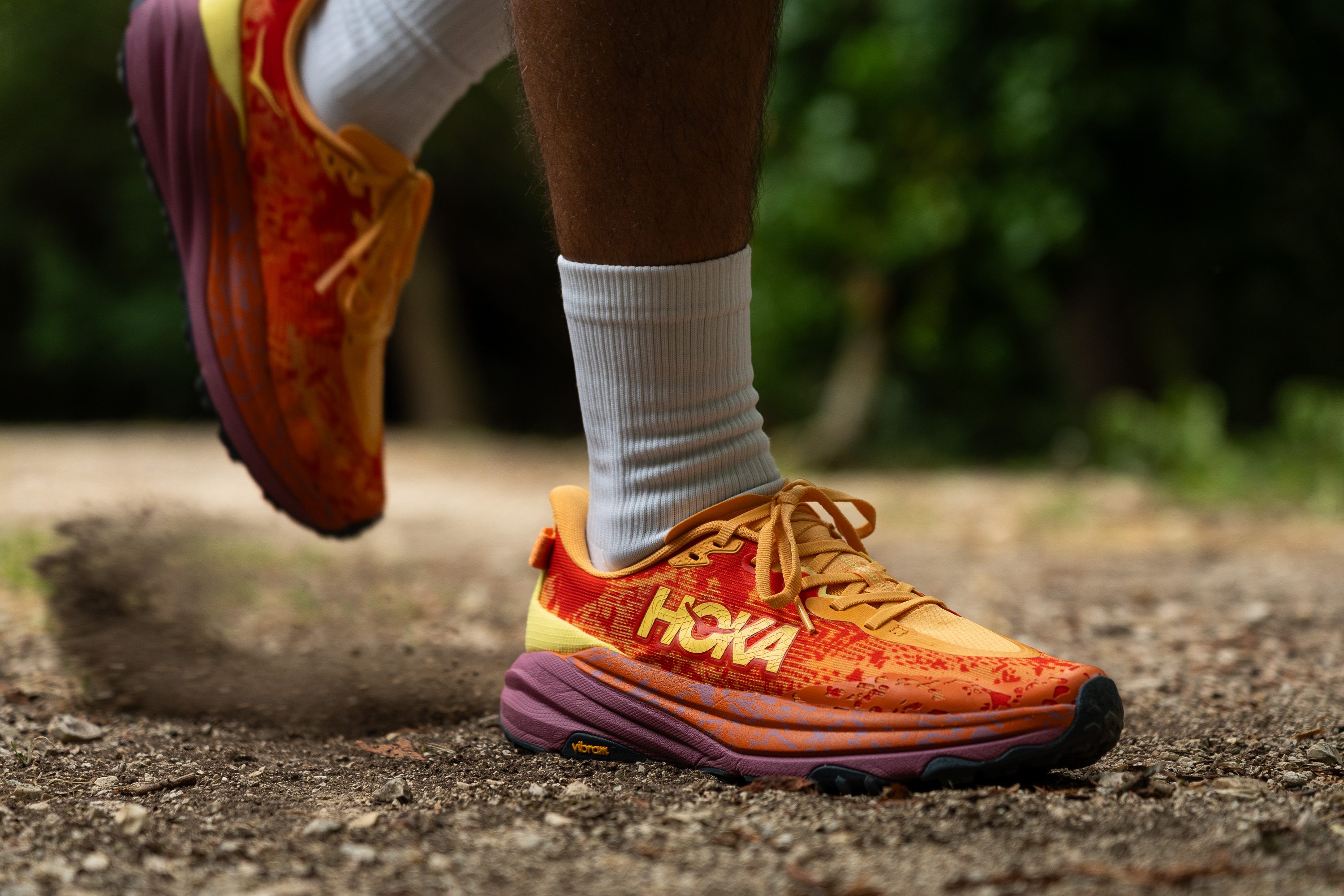
For those who enjoy peppy, energy-returning foams, we believe the Speedgoat 6 may be underwhelming, and we recommend upgrading to the Mafate Speed 4. However, if energy return isn't a priority for you, this CMEVA foam will excel in durability, and provides a balanced feel underfoot, measured at 20.1 HA with our durometer.

| Hoka Speedgoat 6 | 20.1 HA |
| Average | 21.9 HA |
Rocker
The Speedgoat 5 was already known for its rockered sole—for being a trail shoe—which facilitates smooth heel-to-toe transitions, and we discovered that version 6 not only retains this feature but also boosts it slightly in the forefoot.
While this adjustment is subtle, it's also necessary to counteract the reduced flexibility caused by the thicker midsole.
Size and fit
Size
Hoka Speedgoat 6 fits slightly small (123 votes).
Internal length
| Hoka Speedgoat 6 | 270.4 mm |
| Average | 269.0 mm |
Width / Fit
Hoka is known for its narrow fit, yet in our initial test, we were surprised to discover an average reading of 95.6 mm. That should work for most feet out there!
And it was especially interesting to discover this result since the Speedgoat 6 we purchased is a standard width (D), although it's also available in a Wide size (2E).

| Hoka Speedgoat 6 | 95.6 mm |
| Average | 95.6 mm |
Toebox width
Measuring the width of the gel mold at the big toe resulted in 73.0 mm. While it’s not the strongest taper from this brand—something we celebrate—it’s far from wide-foot-friendly and completely unsuitable for those with square-shaped feet.
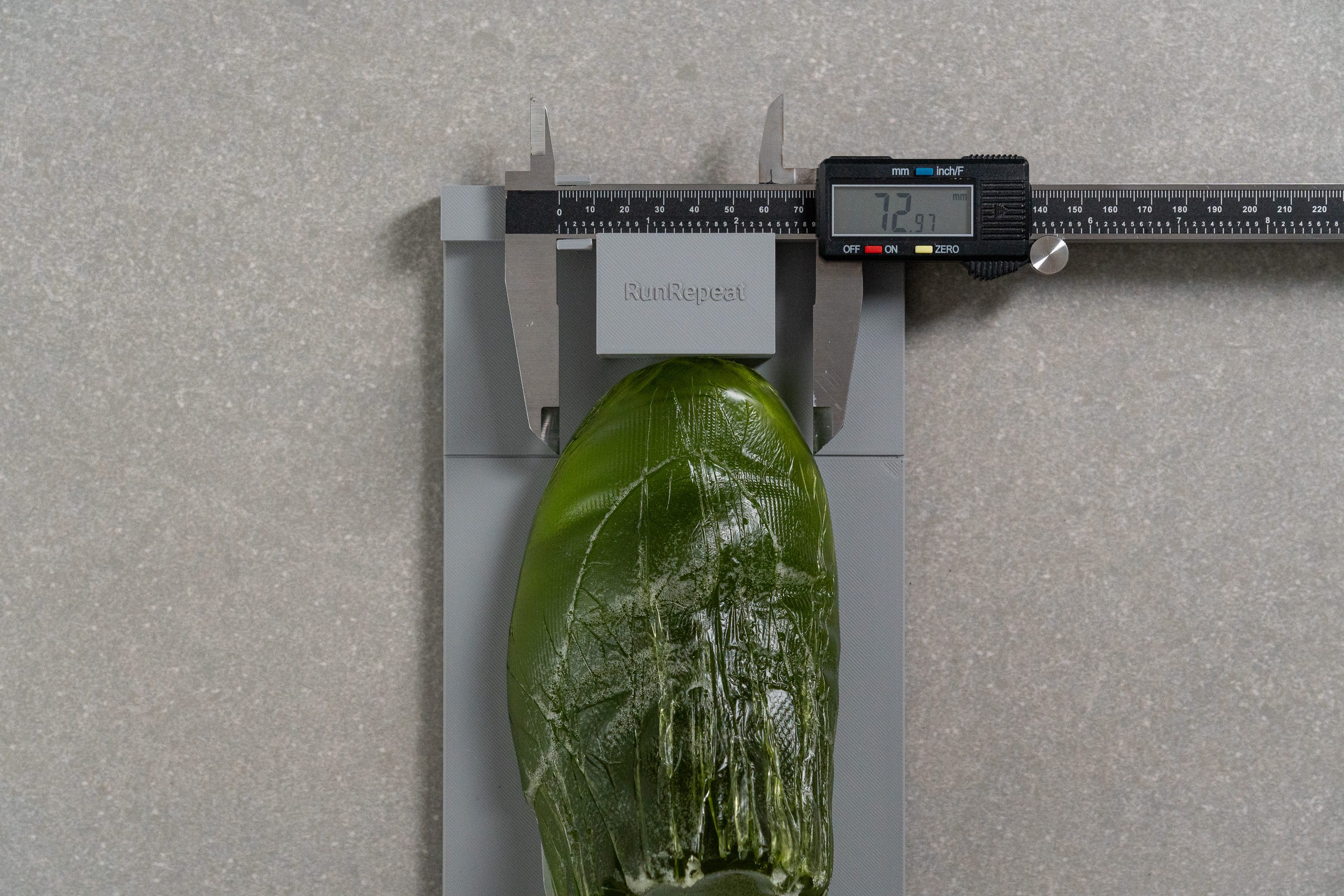
| Hoka Speedgoat 6 | 73.0 mm |
| Average | 74.6 mm |
Toebox height
In terms of vertical room, the Speedgoat 6 feels similar to its width—a bit limited but close to average. This makes it a solid choice for those who appreciate a secure fit during descents, where a high-volume upper can be troublesome.

| Hoka Speedgoat 6 | 26.1 mm |
| Average | 27.1 mm |
Traction / Grip
Lug depth
The Megagrip outsole incorporates the latest technology from Vibram for enhanced grip—Traction Lugs. These micro-protruding dots on the sides of each 4.0-mm lug significantly boost traction, proving especially effective during sharp turns or steep inclines.
While Hoka has revamped the rubber placement, the shape, depth, and orientation of the lugs have remained largely unchanged.

| Hoka Speedgoat 6 | 4.0 mm |
| Average | 3.5 mm |
Outsole design
The Speedgoat 6 keeps the full-length Vibram Megagrip outsole with multidirectional lugs, but there are some subtle design shifts from the Speedgoat 5. The new pattern is slightly more streamlined, with shallower grooves between the lugs and a tighter spacing near the forefoot and heel.

Flexibility / Stiffness
We previously discovered that the torsional rigidity of the Speedgoat 6 resembles that of carbon-plated shoes. But what about its longitudinal stiffness?
Using our custom-made machine, we found it has a somewhat regular stiffness at 18.4N, which is quite reassuring. A super-stiff Speedgoat would have been disappointing, as this shoe is meant to offer both comfort and versatility.
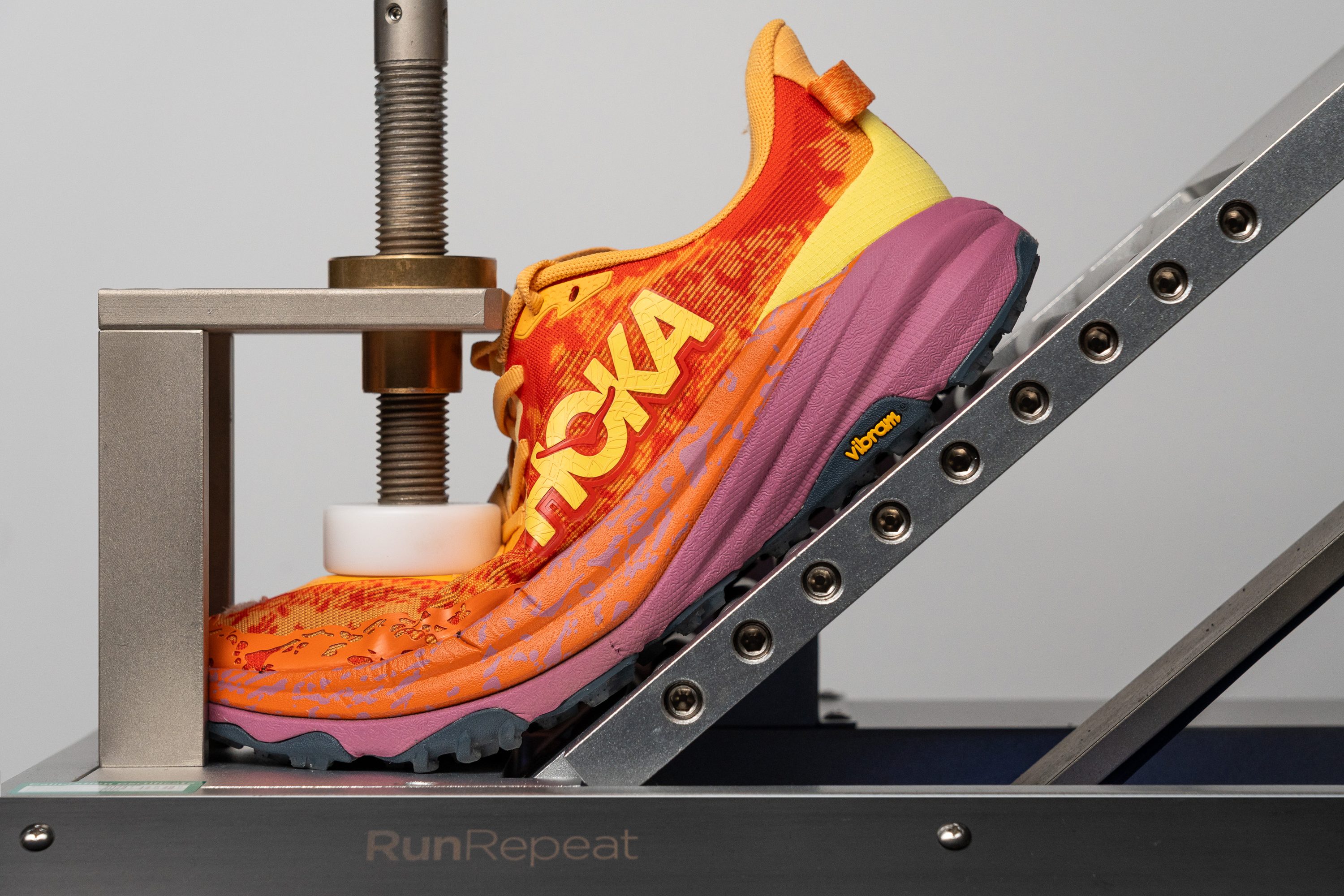
| Hoka Speedgoat 6 | 18.4N |
| Average | 14.7N |
Weight
When we first tested the Speedgoat 6 on the trails, it neither felt lightweight nor heavy—it struck a fine balance, much like its predecessor, version 5.
Back in the lab, we were impressed to find that Hoka managed to keep the shoe under the 10 oz benchmark, despite an increase in cushioning. We recorded a weight of 9.8 oz or 278g, which is quite remarkable!
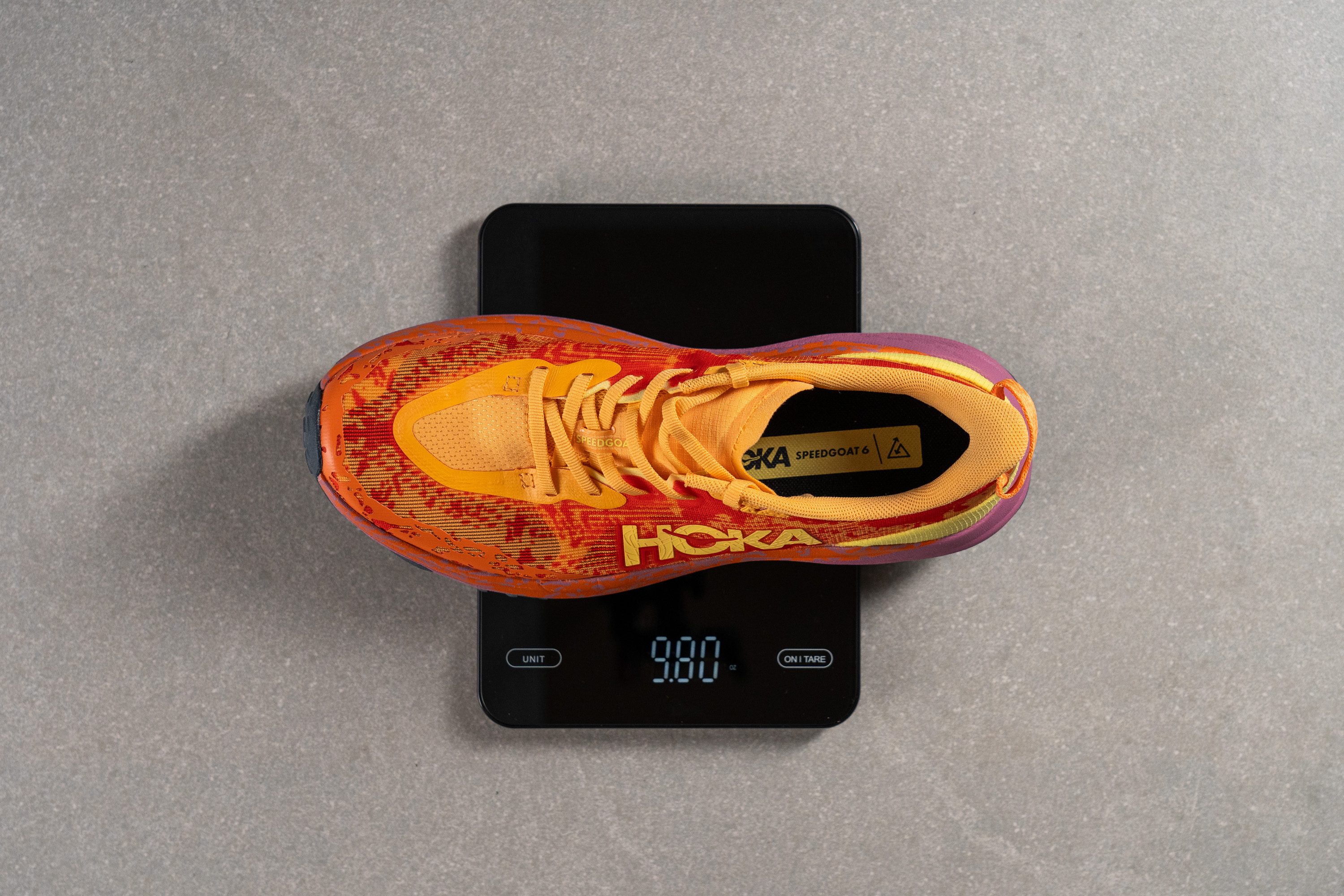
| Hoka Speedgoat 6 | 9.8 oz (278g) |
| Average | 10.2 oz (289g) |
Breathability
Our first assessment of the Speedgoat 6 focused on a crucial feature for ultrarunners, especially during the summer: breathability. Unfortunately, it proved to be a letdown for us. Employing our smoke-pumping machine, we discovered that the SG6 lacked airflow, earning a disappointing 2/5 for airflow.
Driven by curiosity to understand why, we illuminated and examined the sliced upper. Although we found thinner sections, the majority of the shoe is covered with TPU overlays or thicker material and shows little ventilation. This really needs further investigation in our lab.
With those unanswered questions, we turned to our microscope for a deeper look.

Here, we unveiled the truth: the new mesh used by Hoka is extremely dense and features basically no ventilation holes. This lack of airflow is ideal for cold conditions but is a major drawback for warmer weather.
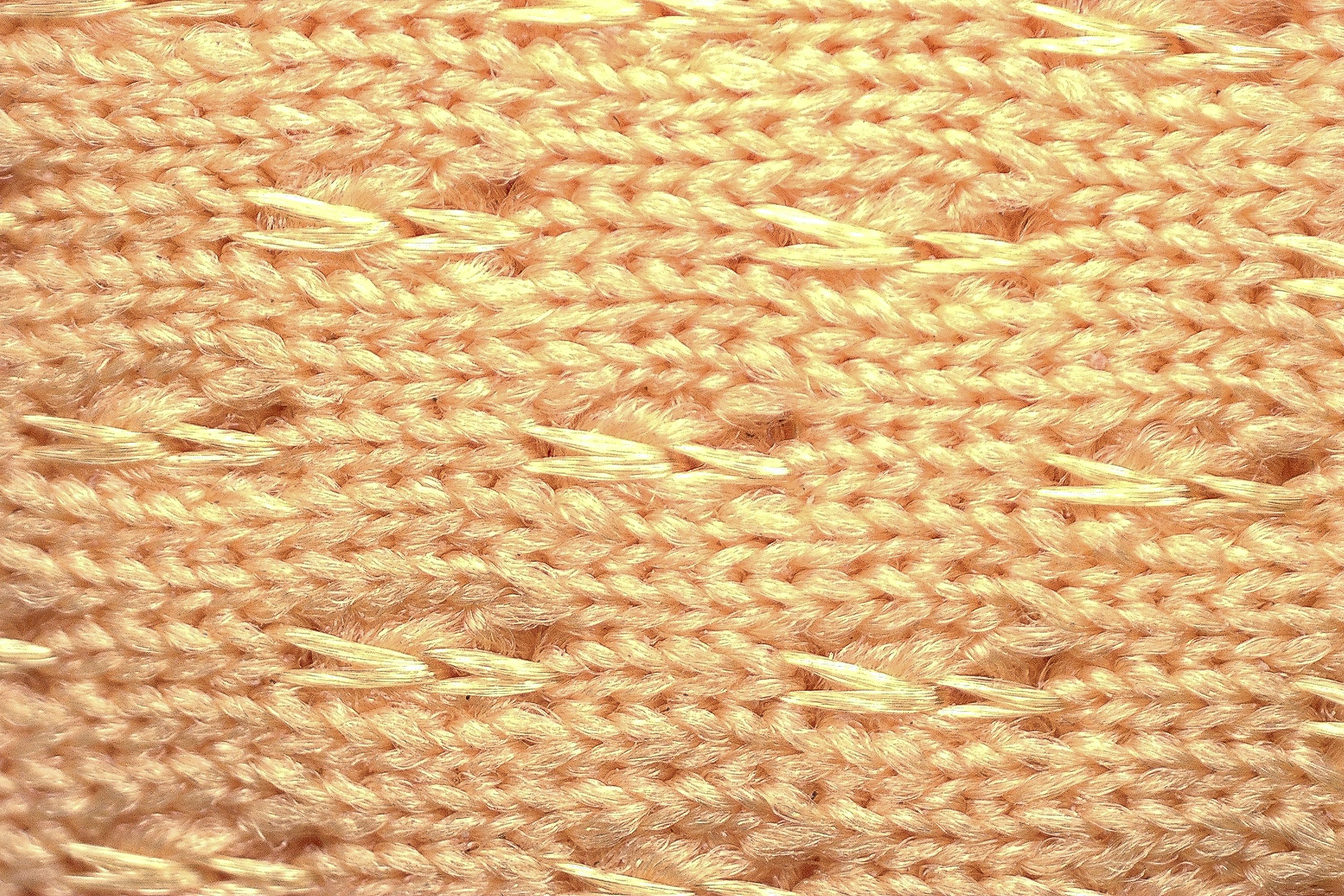
We also took a detailed look at the upper. It’s well padded, which adds to the comfort, but Hoka opted for a single-layer design that is rare in trail toeboxes. This decision likely stemmed from a desire to prevent any further reduction in airflow.
From our analysis, it’s clear that while the SG6 excels in winter conditions, this shoe is not suited for hot summers.
| Hoka Speedgoat 6 | 2 |
| Average | 3.2 |
Stability
Lateral stability test
The Speedgoat series has long been celebrated for its versatility on the trails, and we've also found it to be remarkably stable compared to other trail shoes—a feature that often goes unnoticed. And that's not fair.
We discovered that version 6 has improved stability even further. Let’s explore why.
Torsional rigidity
One of the significant updates Hoka has introduced to enhance stability in the Speedgoat is by increasing its rigidity, scoring a maximum 5/5 on our scale—even without the inclusion of a plate. While this boosts stability, it's a double-edged sword; the added rigidity can make the shoe less suited for technical terrain and somewhat reduces comfort.
| Hoka Speedgoat 6 | 5 |
| Average | 3.6 |
Heel counter stiffness
Another step towards enhanced stability in the Speedgoat 6 is the heel counter.
The previous SG5 featured a pliable, soft counter that we rated at 2/5, but the sixth version is notably stiffer, earning a 3/5 from us. However, it remains quite average, similar to those found in everyday road trainers, which means it's unlikely to bother your Achilles tendon.
| Hoka Speedgoat 6 | 3 |
| Average | 3 |
Midsole width - forefoot
The Speedgoat remains a substantial shoe in terms of size, measuring 117.7 mm in the forefoot, similar to its predecessor. This dimension provides a broad landing base, enhancing stability across various terrains and maintaining the same supportive feel as the previous generation.
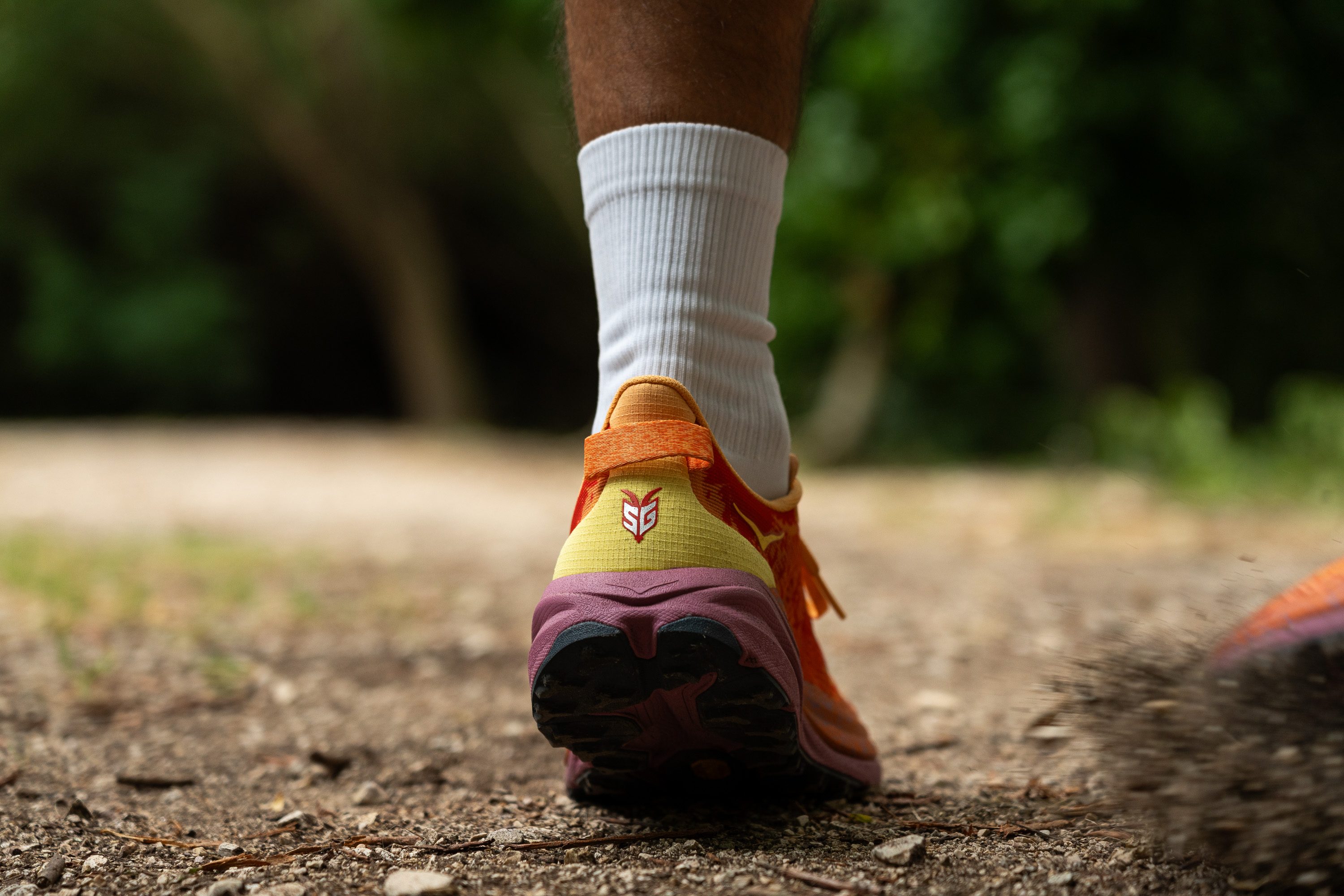
However, the downside of this design choice is that the shoe lacks the agility and speed of shoes like the Zinal 2. But as we've found, there's a trail shoe for every scenario!
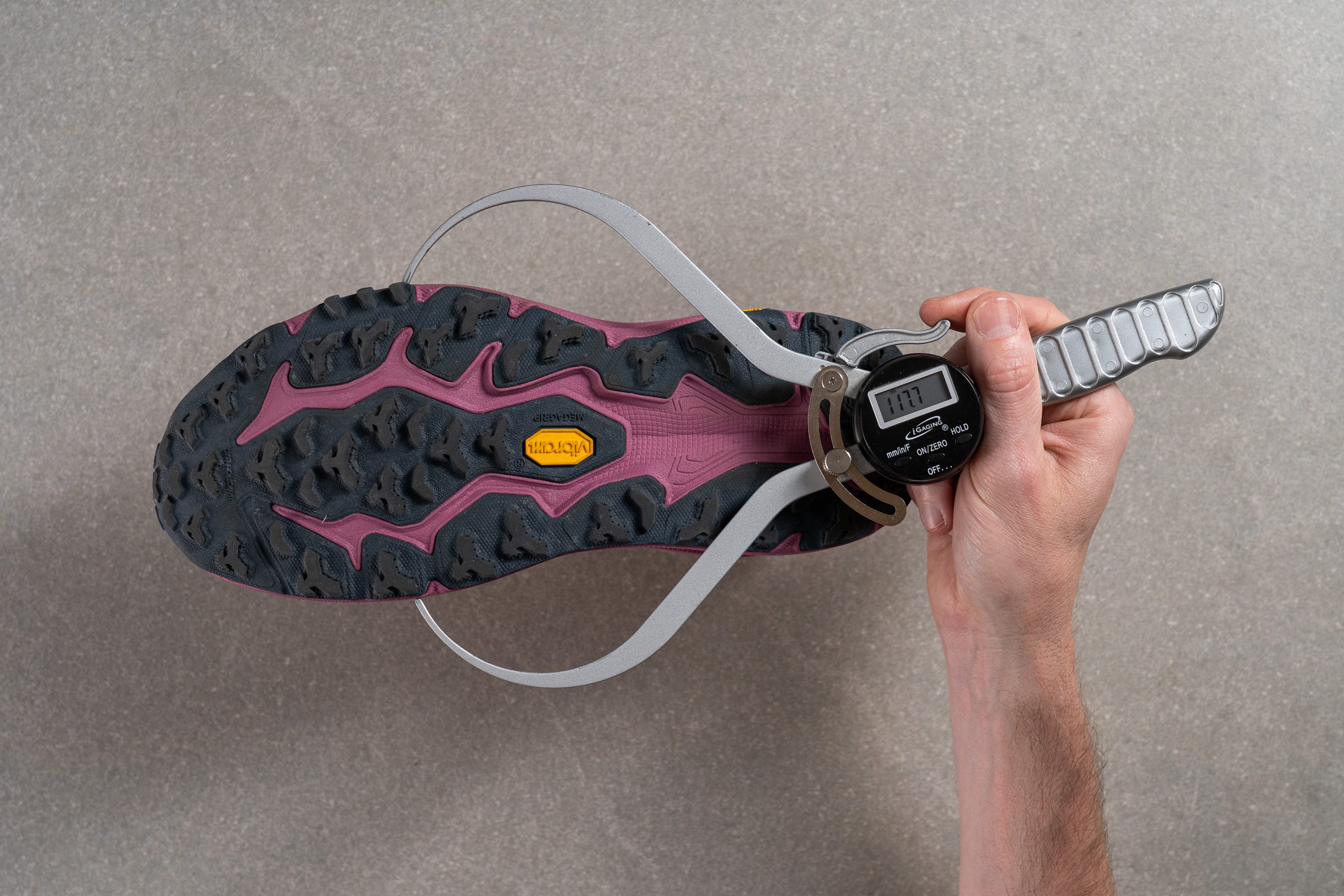
| Hoka Speedgoat 6 | 117.7 mm |
| Average | 112.8 mm |
Midsole width - heel
The heel of the SG6 is slightly narrower than in previous models, yet it still measures a notably wide 94.1 mm under our digital calipers—wider than most trail shoes.
This substantial width is highly effective in stabilizing the heel for runners who land on this part of the foot.
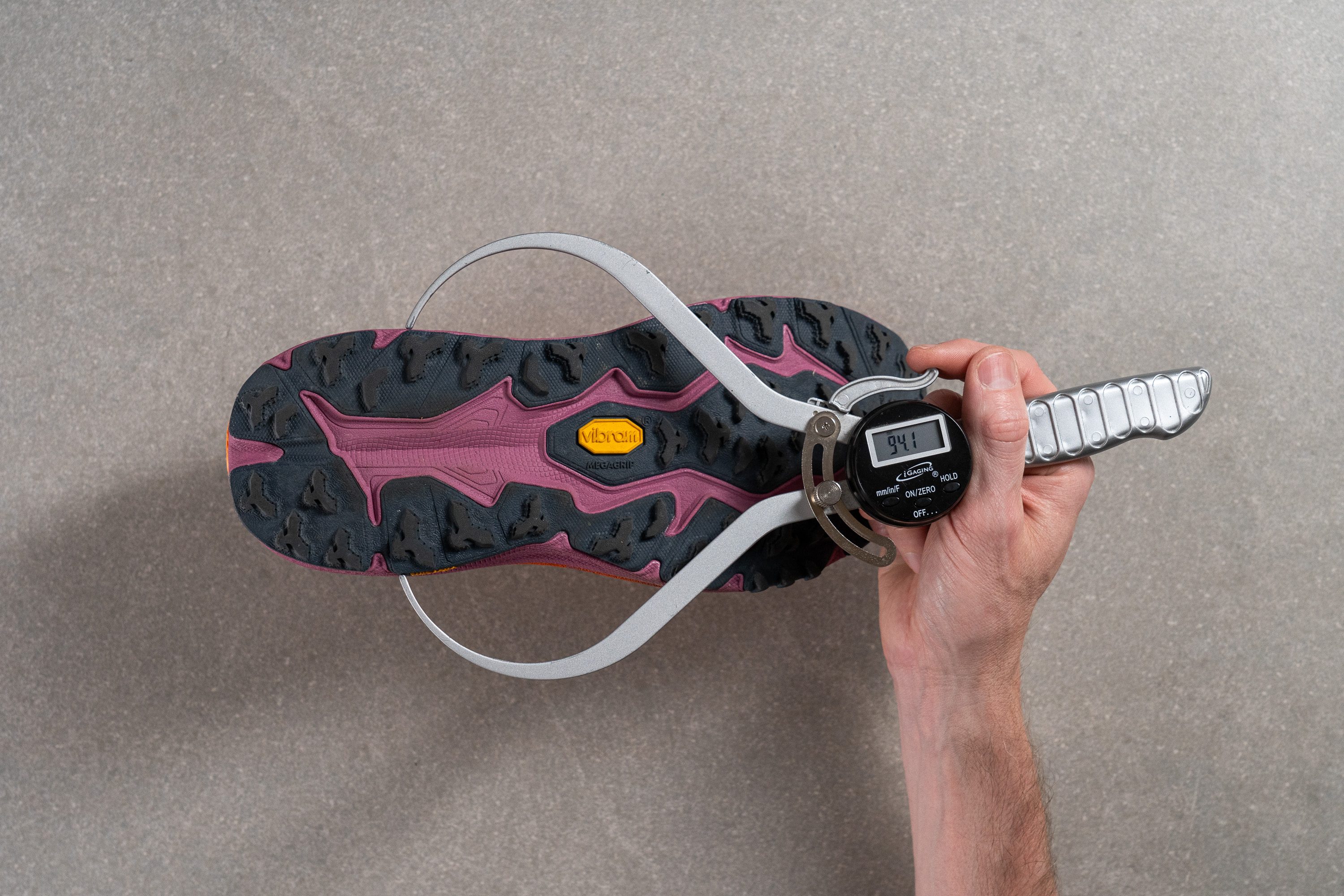
| Hoka Speedgoat 6 | 94.1 mm |
| Average | 89.9 mm |
Durability
Toebox durability
The limited airflow of the Speedgoat 6 does have a silver lining—it typically results in uppers that are more durable, as they feature fewer weak points like ventilation holes. This is certainly true for the Speedgoat 6.
In our initial Dremel test, we discovered that the toebox was remarkably resistant, scoring an impressive 4/5. This performance not only highlights its durability but also sets it apart from many competitors in terms of toughness.
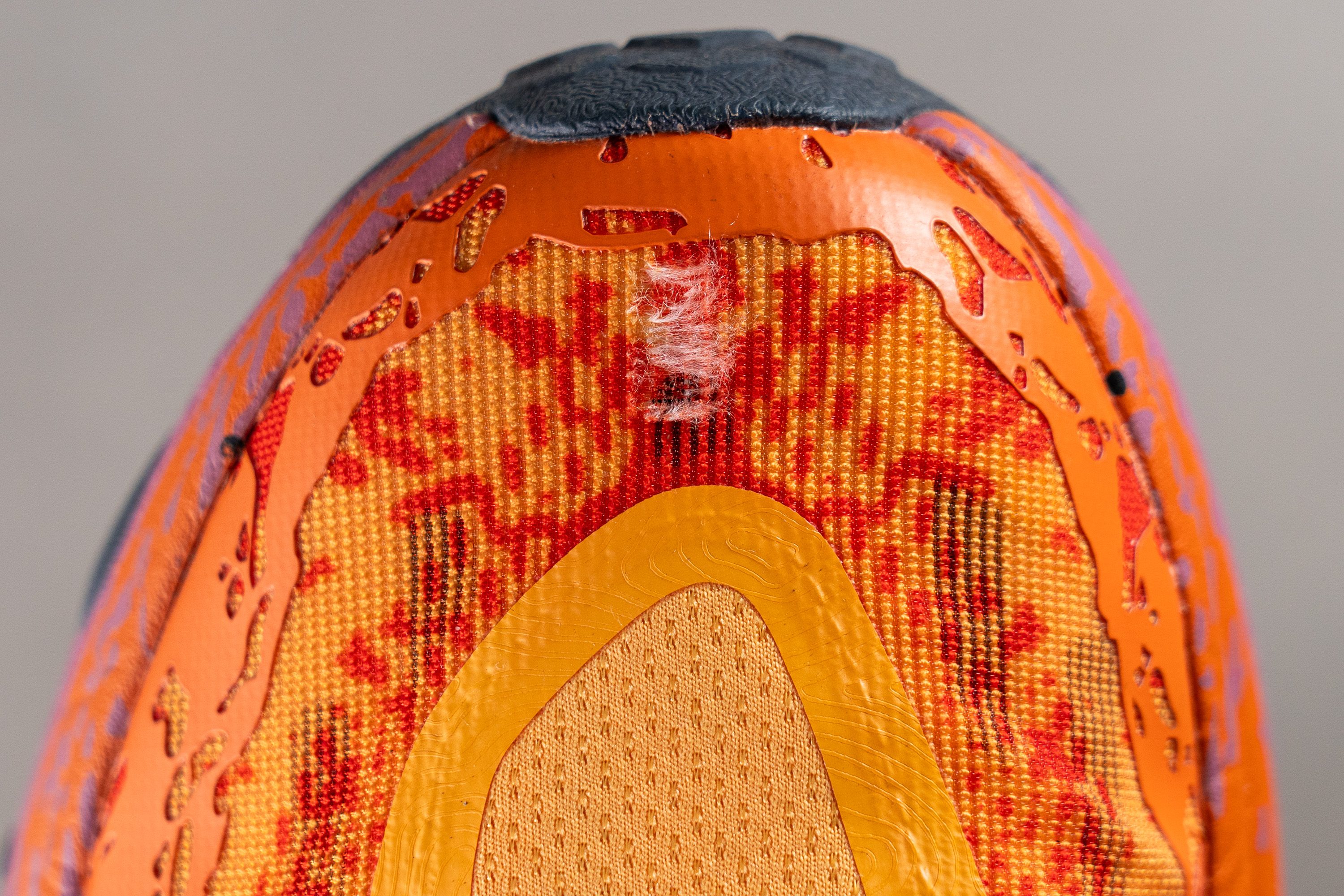
| Hoka Speedgoat 6 | 4 |
| Average | 3.1 |
Heel padding durability
While we had the Dremel running, we took the opportunity to test the heel padding as well—another critical area for many trail runners.
Once again, we encountered a very positive result, with a score of 4 out of 5. This impressive performance elevates the Speedgoat 6 above the majority of trail running shoes on the market.
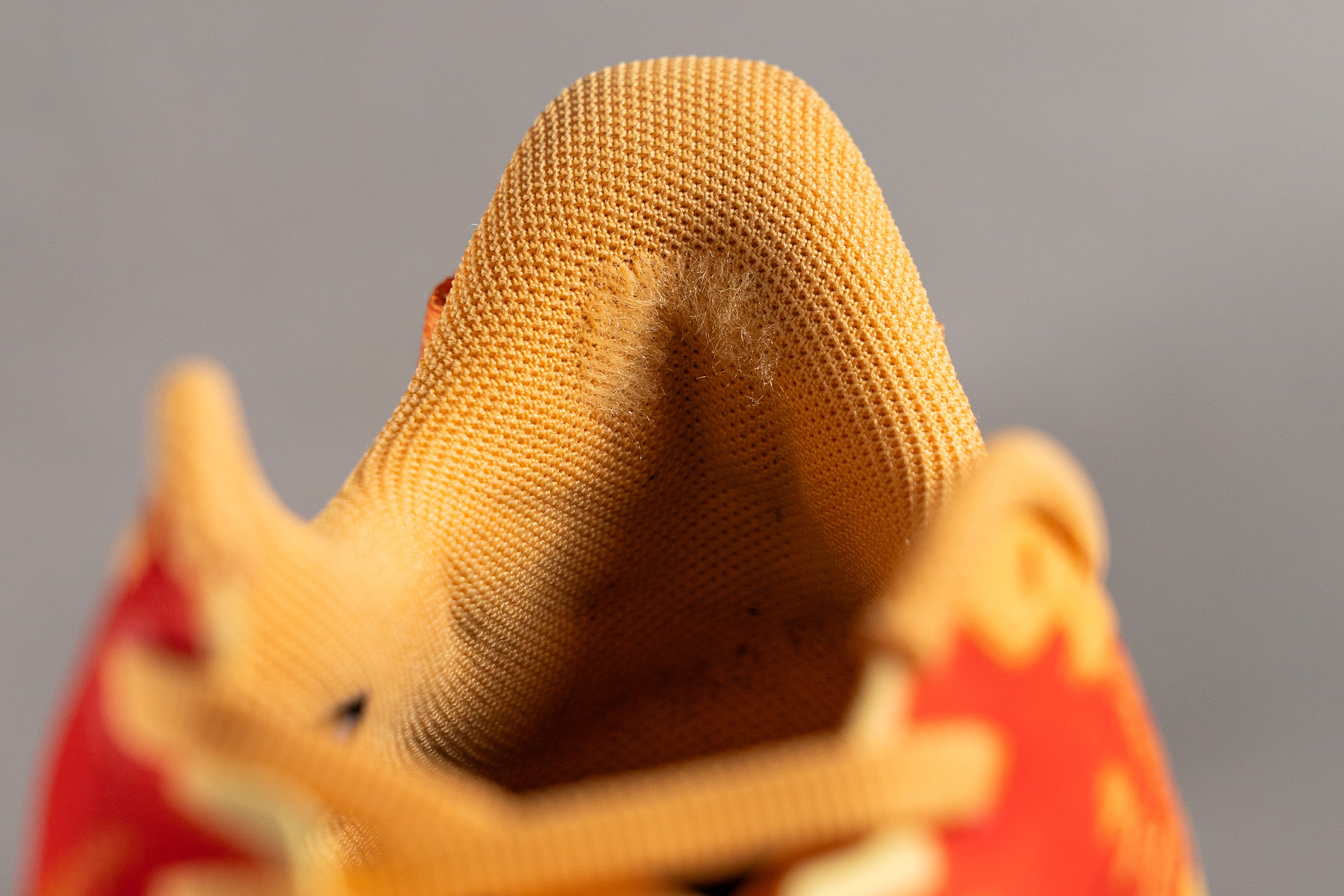
| Hoka Speedgoat 6 | 4 |
| Average | 3 |
Outsole hardness
After mixed results in breathability and durability, we now turn our attention to the outsole of the Speedgoat.
Hoka has renewed its partnership with the Italian-based, industry-leading company Vibram, featuring once more a Megagrip outsole that provides exceptional traction across various conditions and surfaces.
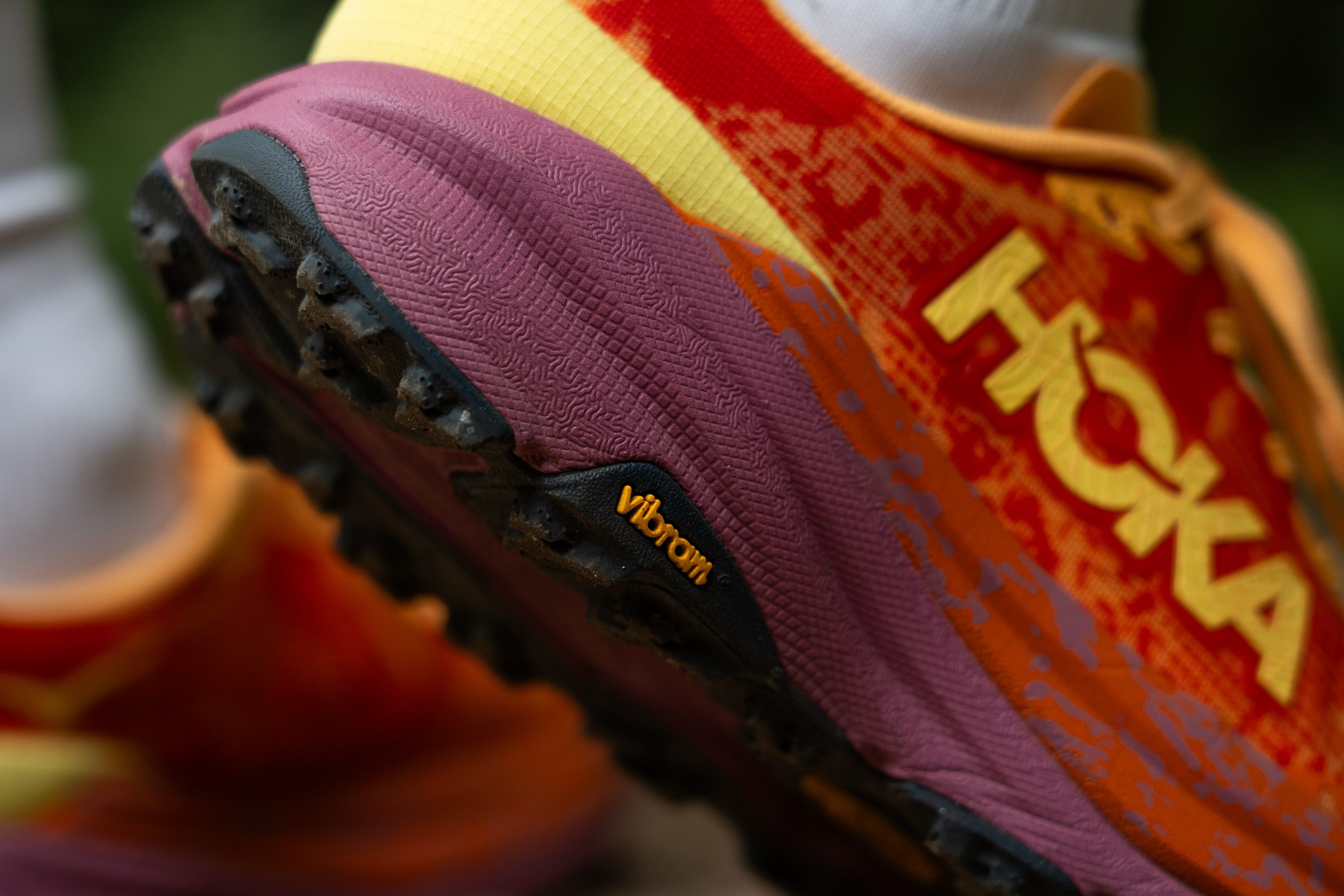
In our initial evaluation, we used our Shore C durometer to measure the rubber's hardness. We discovered that it registers at an average 84.5 HC, indicating a balance between durability and flexibility.
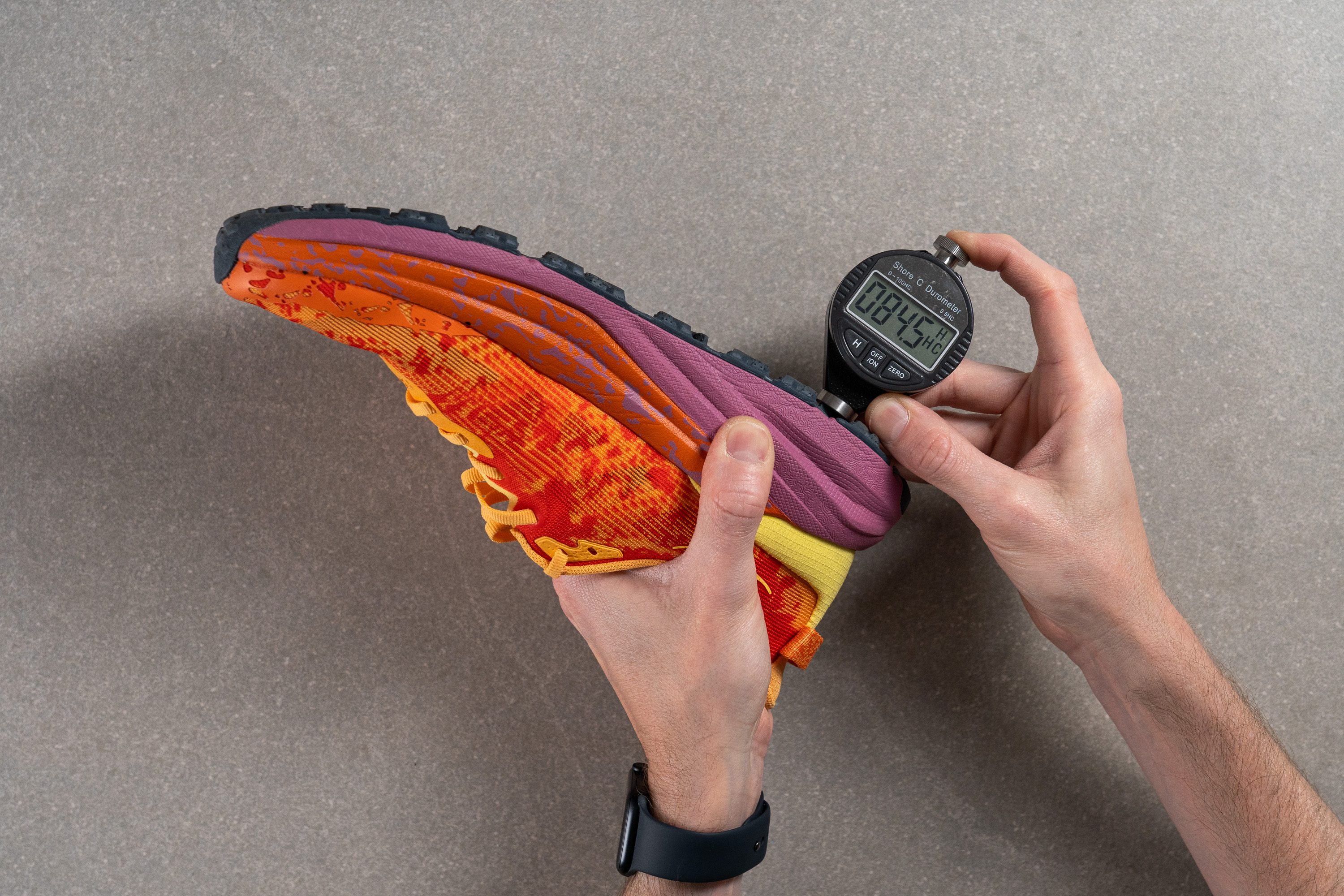
| Hoka Speedgoat 6 | 84.5 HC |
| Average | 85.8 HC |
Outsole durability
In our third and final Dremel test, we doubled the tool's speed to rigorously challenge the rubber, maintaining consistency with our standard testing protocol across all running shoes.
The results were somewhat disappointing. While Vibram Megagrip is known for its durability, the 1.4 mm dent we observed is less than satisfactory—it's not terrible, but it does fall short of our expectations and could suggest reduced longevity of the outsole.
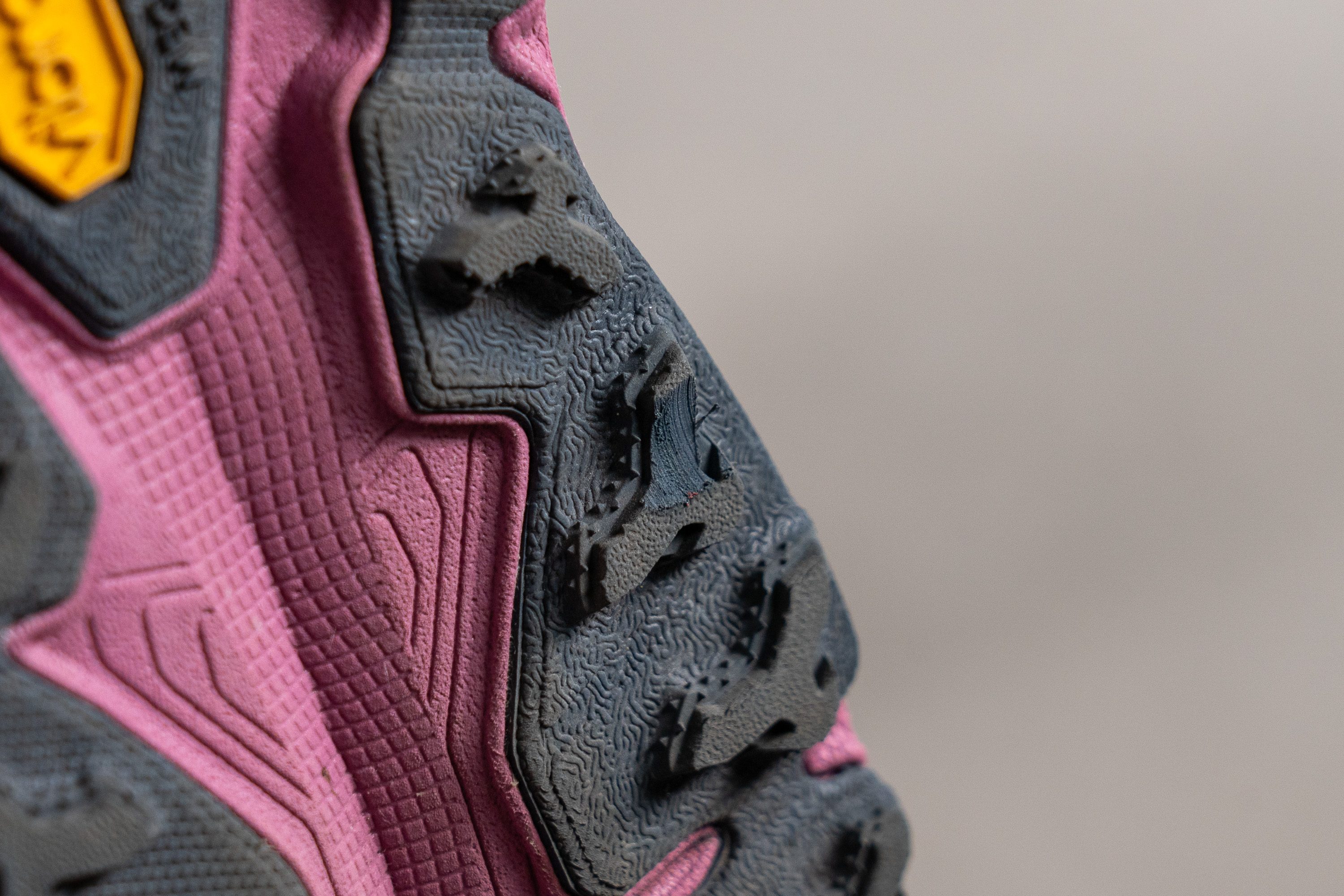
| Hoka Speedgoat 6 | 1.4 mm |
| Average | 0.9 mm |
Outsole thickness
We discovered that the outsole of the Speedgoat 6 is thicker than typically seen in trail shoes at 3.1 mm.
This might seem unusual to most, but it makes sense to us here in the lab. After testing the rubber with the Dremel, it became clear that the Speedgoat 6 requires this extra thickness to compensate for its durability challenges.
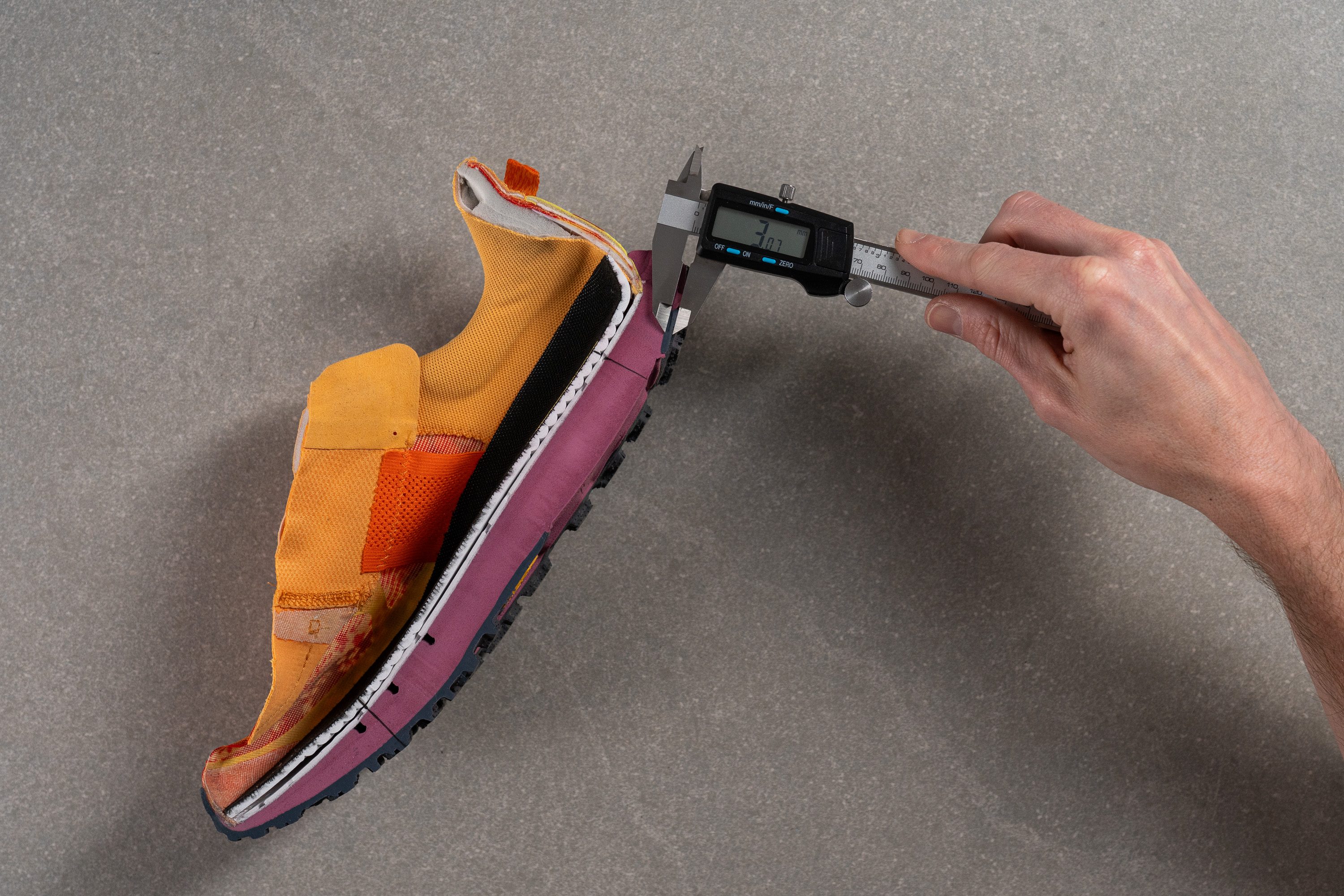
| Hoka Speedgoat 6 | 3.1 mm |
| Average | 2.2 mm |
Misc
Insole thickness
The insole of the shoe is quite basic, featuring a mere 4.3 mm of thickness.
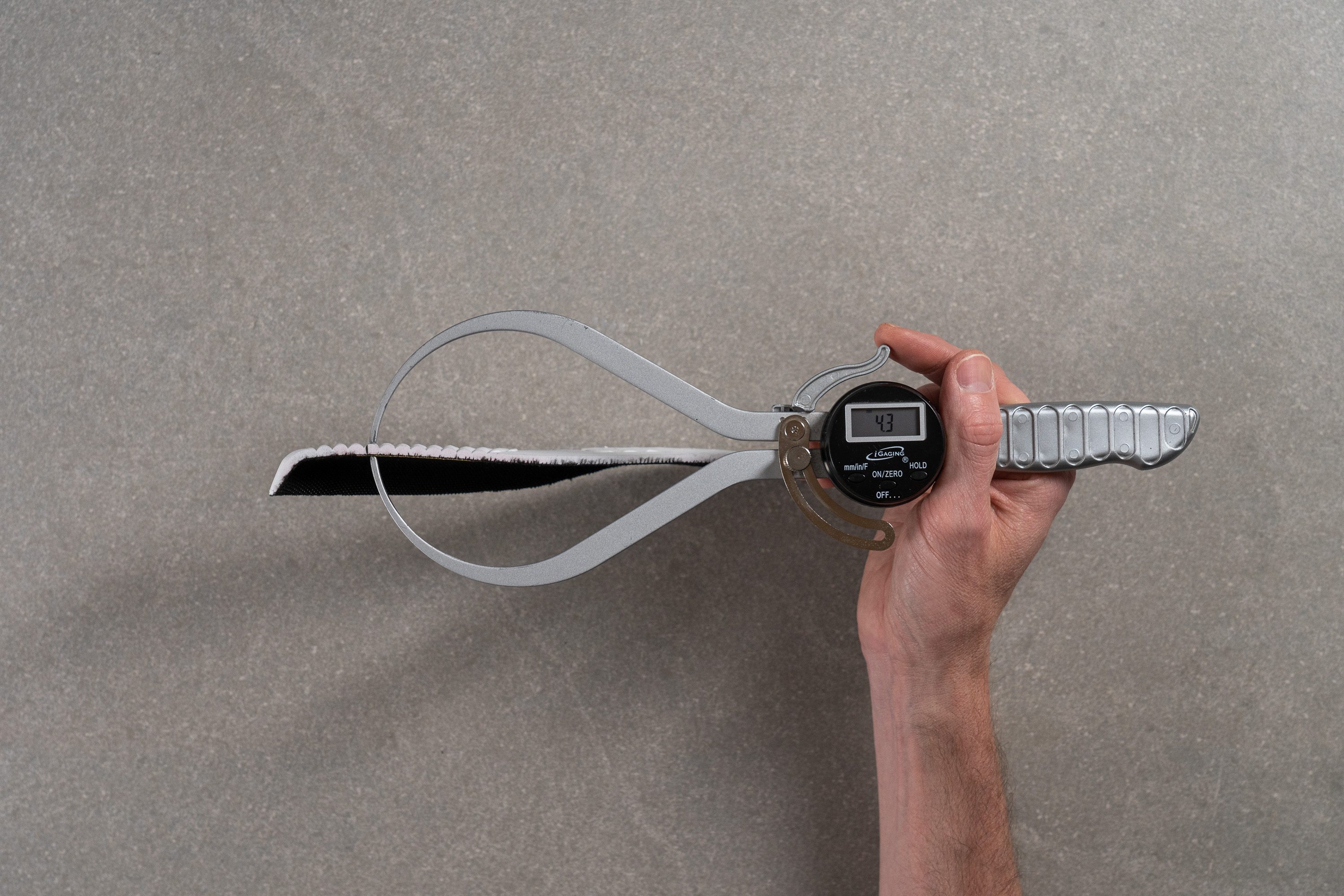
| Hoka Speedgoat 6 | 4.3 mm |
| Average | 4.7 mm |
Removable insole
A delightful feature we loved is the Speedgoat 6 insole. Not only is it removable—it's also perforated, adding a premium touch.
This design choice is particularly beneficial in this shoe, as we've found that the SG6 lacks airflow. Fortunately, the perforated insole and last allows for heat and moisture to escape from multiple directions.

| Hoka Speedgoat 6 | Yes |
Midsole softness in cold (%)
After subjecting the SG6 to a 20-minute stint in the freezer, we tested its softness again and were happy with the outcome. The shoe demonstrated only a 23% increase in firmness, showcasing exceptional cold-weather performance for an EVA-based model.
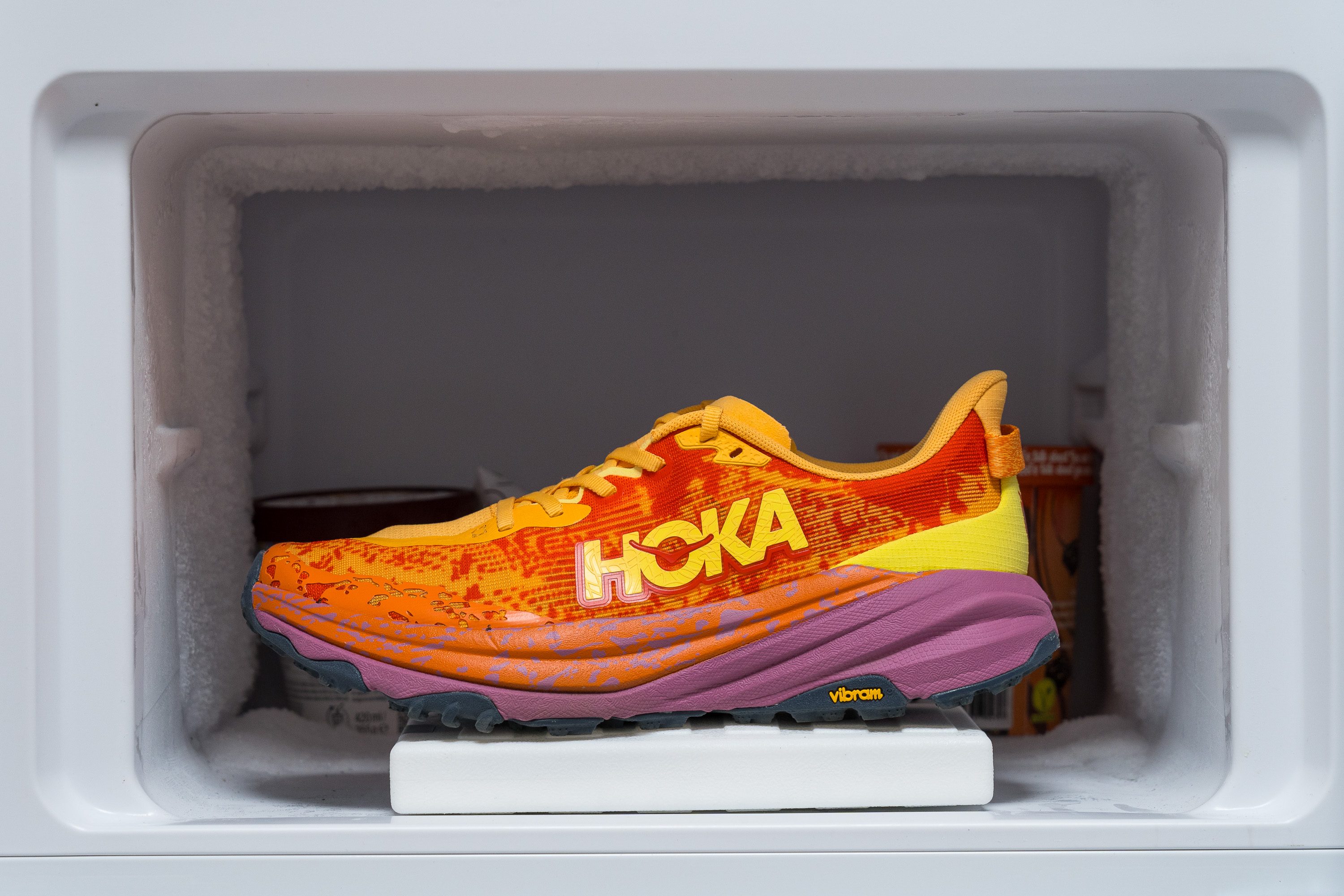
| Hoka Speedgoat 6 | 23% |
| Average | 26% |
Reflective elements
Hoka added reflective elements to the heel—ensuring your competitors can see you as you lead your next ultra.
And it's not just any ordinary reflective detail—it's actually the Speedgoat logo!
| Hoka Speedgoat 6 | Yes |
Tongue padding
In a shoe designed to excel at long distances, a thin tongue often proves to be a drawback. The Speedgoat 5, with its 2.3 mm tongue, lacked adequate padding.
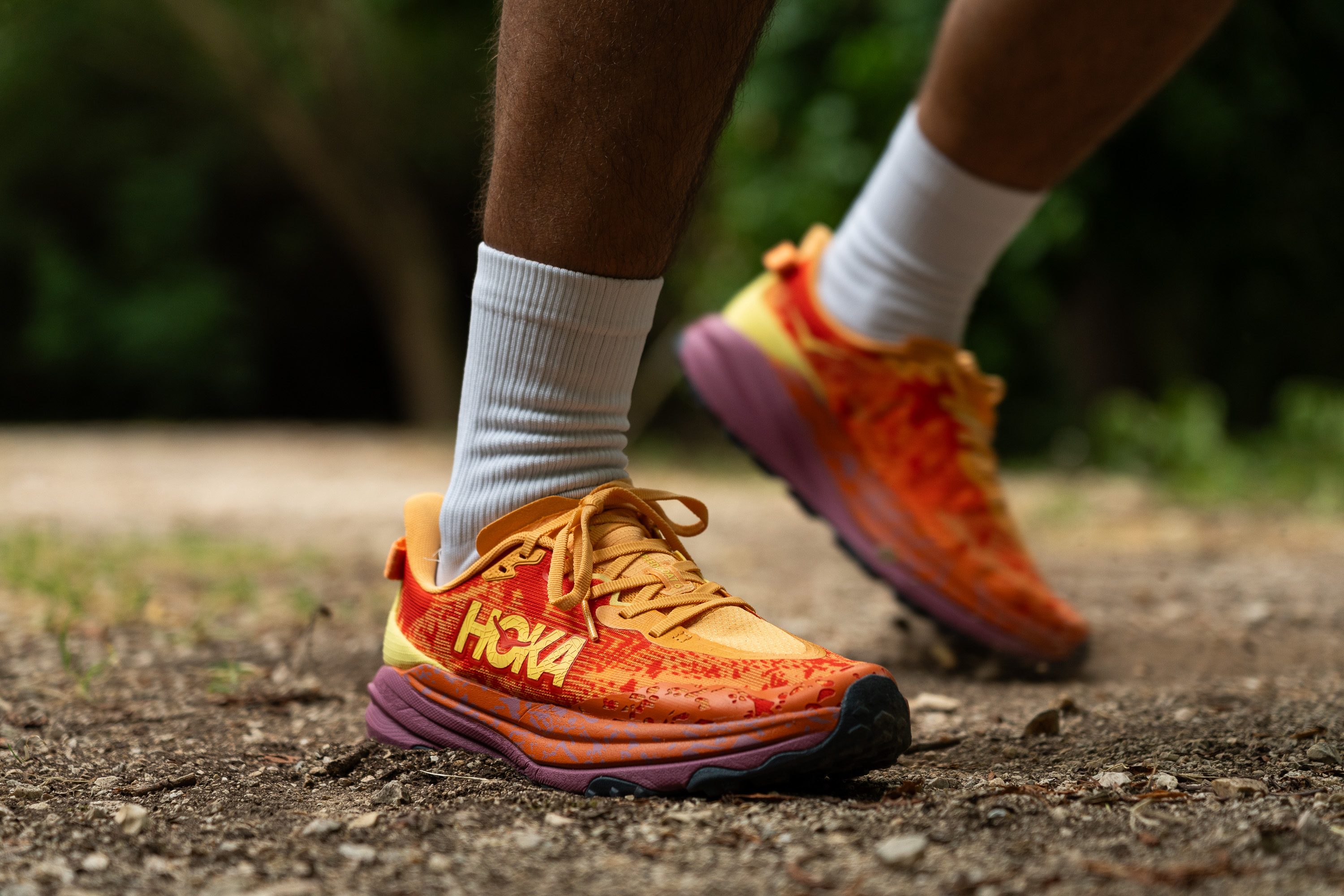
Hoka listened to the feedback from many runners and made significant improvements—kind of. The new version now features a robust 5.2 mm padded tongue—more than double the thickness of its predecessor, strategically placed to cushion the instep where pressure peaks.
However, as can be seen below, the rest of the tongue maintains a super-slim profile, so you still need to be careful tying the laces before every run.
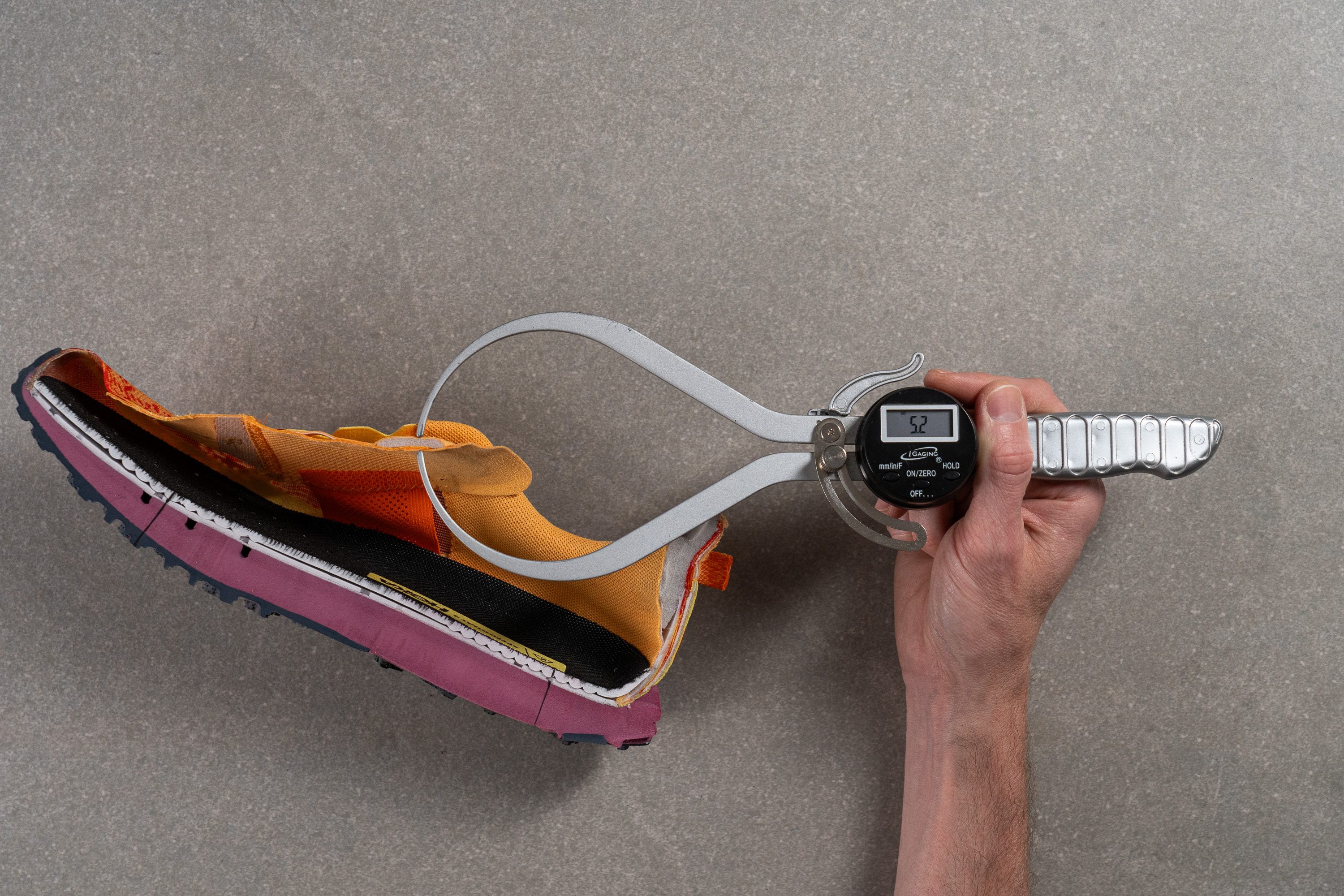
| Hoka Speedgoat 6 | 5.2 mm |
| Average | 6.4 mm |
Tongue: gusset type
While most trail running shoes come with a fully gusseted tongue to block debris, Hoka has chosen a semi-gusseted design for the Speedgoat.
Although this might seem like a slight compromise, it actually suits the shoe's narrow fit quite well, preventing the cramped feeling that a full gusset might cause in those with larger feet.
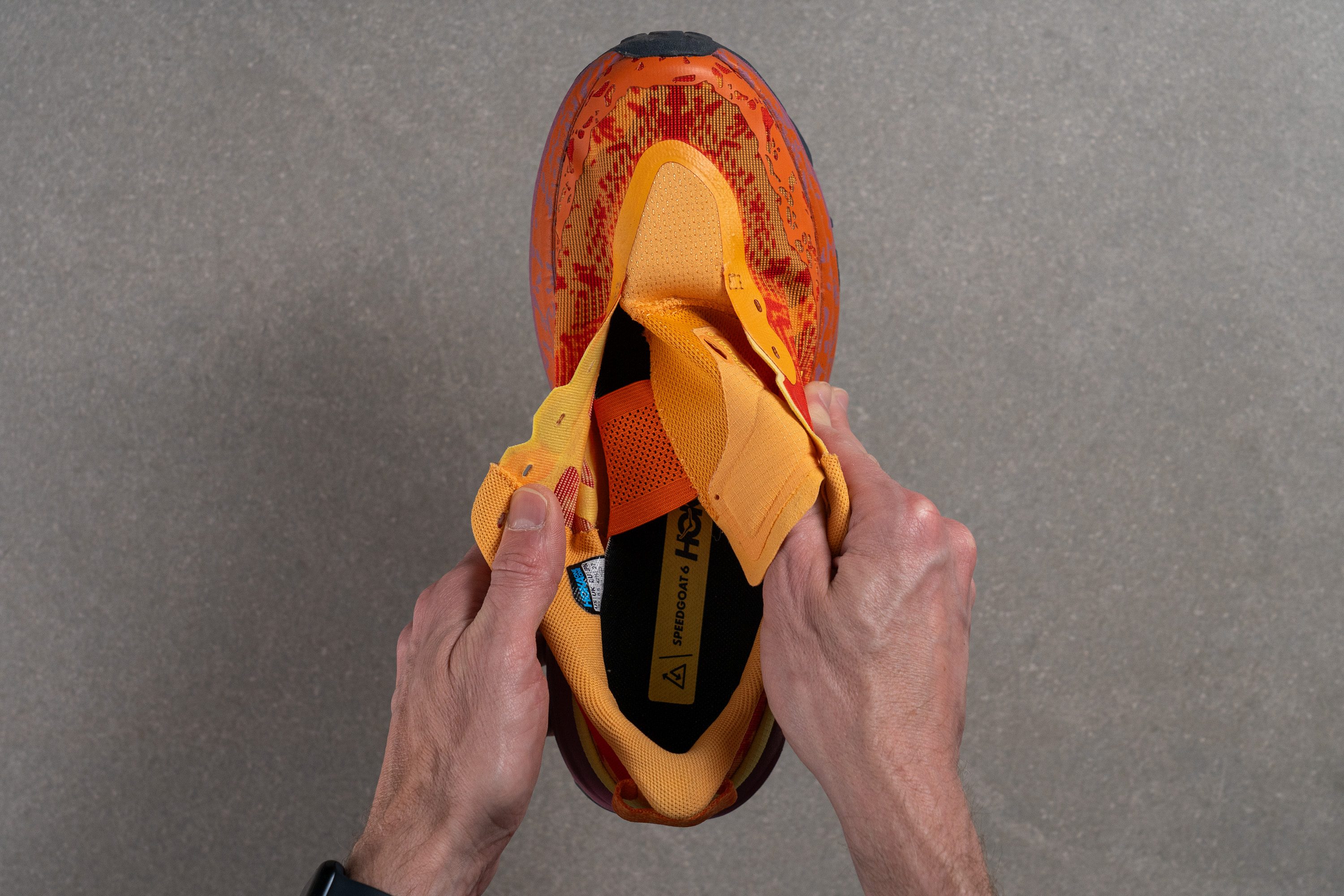
| Hoka Speedgoat 6 | Both sides (semi) |
Heel tab
Another debated design element of the Speedgoat 5 was the absence of a finger-loop heel tab. However, this issue has been addressed in the Speedgoat 6, which now includes a convenient horizontal tab.
We also want to highlight that the heel has been redesigned to fix the issues with the SG5's flared collar, which occasionally acted like a funnel, collecting debris inside the shoe.
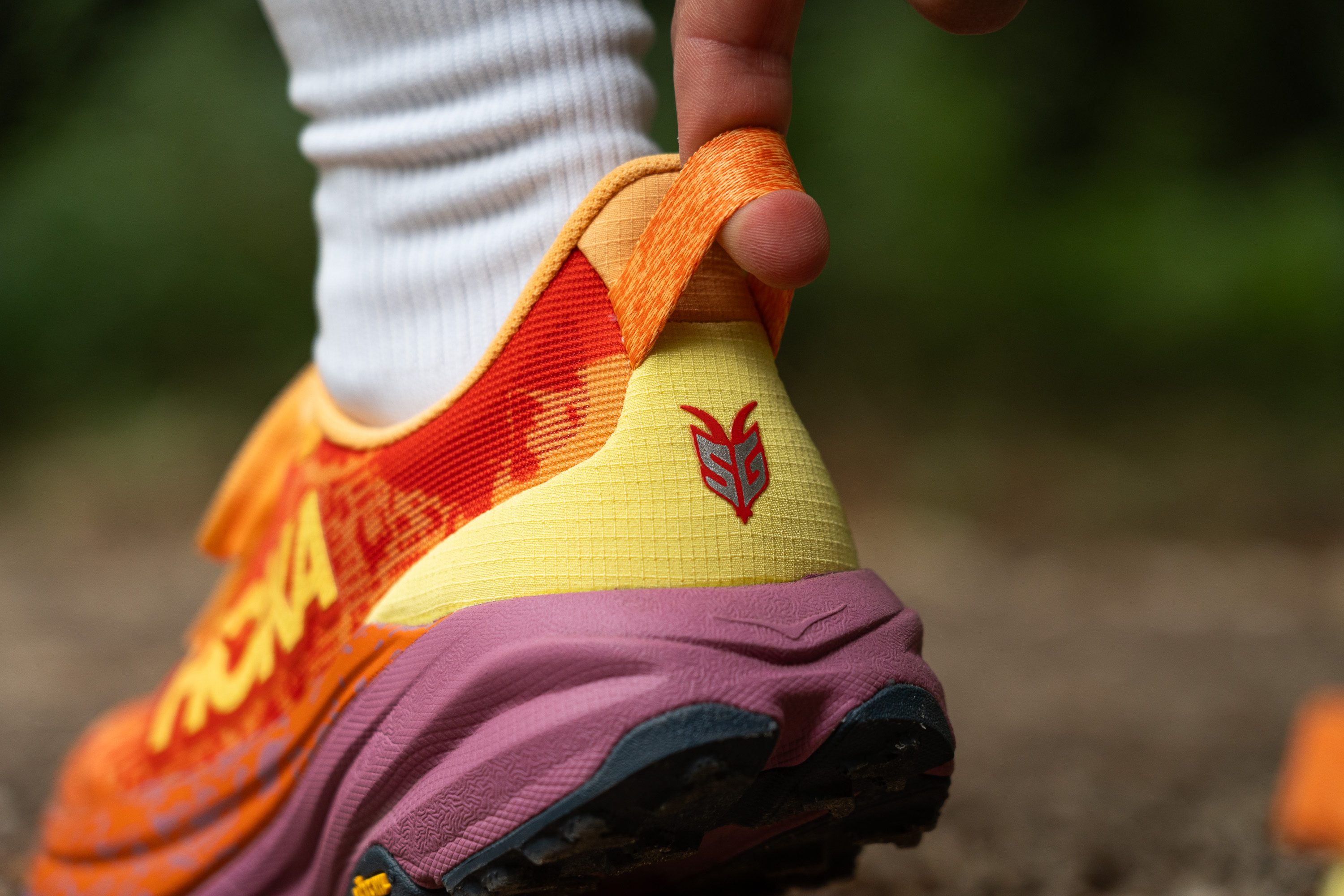
| Hoka Speedgoat 6 | Finger loop |





























































